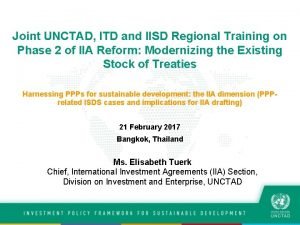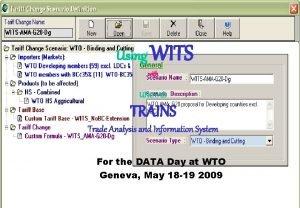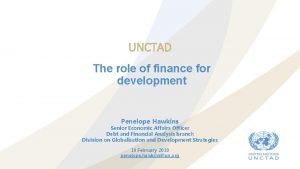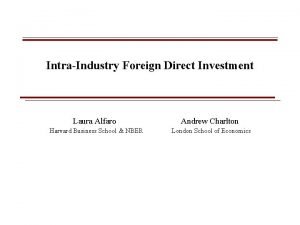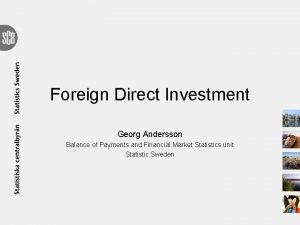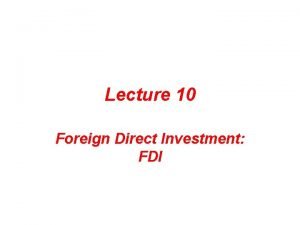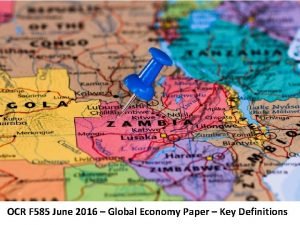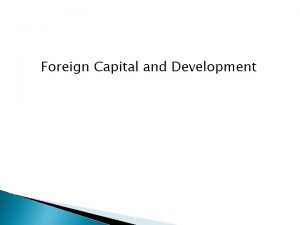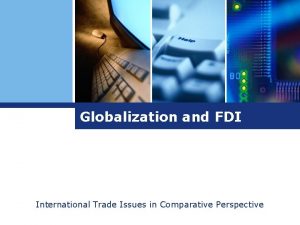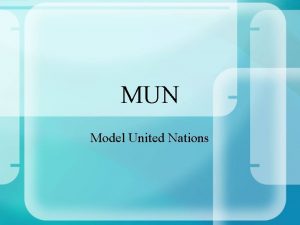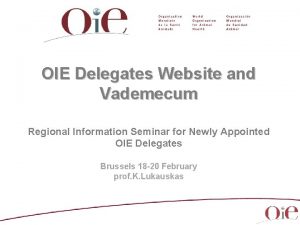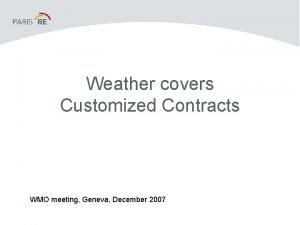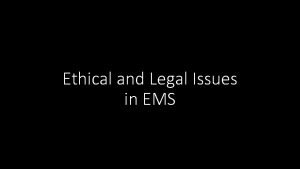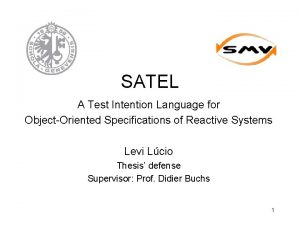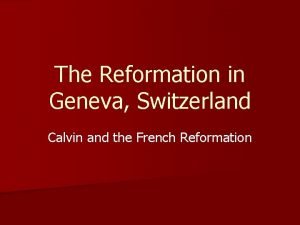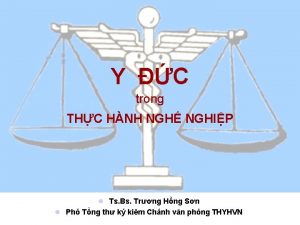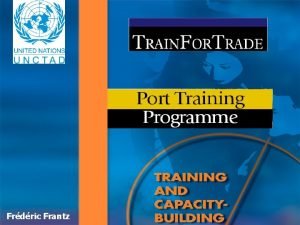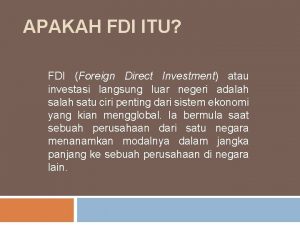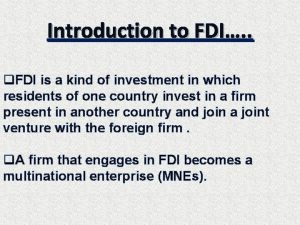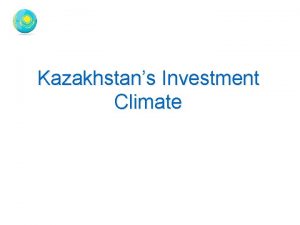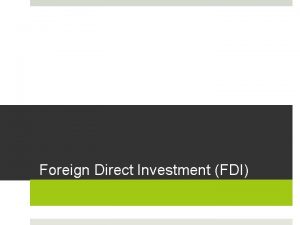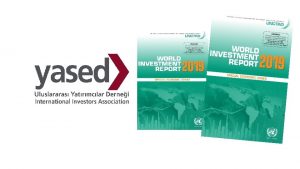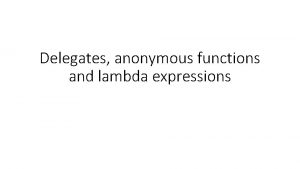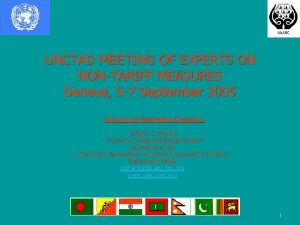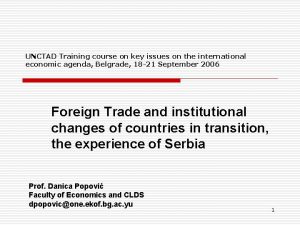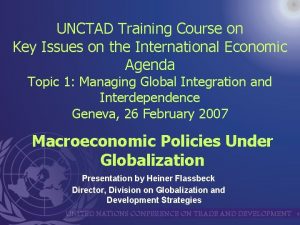UNCTAD COURSE FOR GENEVA DELEGATES ATTRACTING FDI THROUGH
















































- Slides: 48

UNCTAD COURSE FOR GENEVA DELEGATES ATTRACTING FDI THROUGH INTERNATIONAL INVESTMENT AGREEMENTS 25 June 2007 Mr. Joachim Karl and Mr. Hamed El-Kady International Arrangements, DITE United Nations Conference on Trade and Development

I. Recent FDI trends 2

FDI Flows 1980 - 2006 (Billions of dollars) 3

Top 10 recipients of FDI inflows WORLD INVESTMENT REPORT 2006 4

Largest 10 sources of FDI outflows … but developing economies are becoming emerging sources … Hong Kong (China) 10 th and China 17 th WORLD INVESTMENT REPORT 2006 5

FDI constitutes the largest component of resource flows to developing countries Billions of dollars 6

National policy changes Countries continue to adopt liberalization measures. 7

New regional and global TNCs are emerging ü ü Emerging economies account for about 25% of all TNCs In 1990, there were 19 such companies among the Fortune 500; by 2005, the number had risen to 47. Most global players based in Asia State ownership relatively common compared with developedcountry counterparts WORLD INVESTMENT REPORT 2006 8

II. Recent trends in international investment rulemaking 9

Changes in policy environment The IIA network evolves within a changing policy environment. Examples are: n n Signs of a possible FDI backlash in some countries; More developing countries are becoming capital exporters. 10

The network of international investment agreements Ø Ø Bilateral investment treaties (BITs) Free trade agreements with investment provisions (FTAs) Multilateral agreements dealing with investment (GATS, TRIMs, TRIPs, MIGA) Regional integration agreements (EU, CARICOM, MERCOSUR, ASEAN) 11

Bilateral investment treaties (BITs) What are BITs? Ø Bilateral reciprocal agreements aimed at protecting and promoting foreign investment through legallybinding rights and obligations. 12

Universe of BITs continues to grow rapidly Number of BITs concluded, cumulative, 1995 -2006 Over 2500 BITs 13

Proliferation of FTAs with investment provisions Ø International investment rules are increasingly being formulated as part of agreements that encompass a broader range of issues (including trade, services, competition, intellectual property); Ø Such as free trade agreements, regional integration agreements, partnership agreements, or economic cooperation agreements; Ø The total number of such economic agreements with investment provisions exceeded 240, as of end 2006. 14

Active participation of developing countries in IIAs Ø Ø Ø Many developing countries are active participants in the process of concluding IIAs. E. g. DCs involved in 75% of all BITs. The total number of BITs between developing countries leaped from 47 in 1990 to over 650 by the end of 2006. By end 2006, over 90 other IIAs among developing countries had been signed. 15

South-South cooperation is intensifying in the context of IIAs 16

Total BITs concluded as of end 2006, by country group 17

"Top ten" economies signatories of BITs, end 2006 18

Increasingly sophisticated and complex n n More recent BITs tend to be increasingly sophisticated in content, clarifying in greater detail the meaning of a number of standard clauses and putting more emphasis on the protection of national security, health, safety, the environment, and labour rights. A growing number of BITs are expanding their scope with a broader set of issues, including investment in financial services. 19

Number of investor-State dispute cases (end 2006) 20

Conclusions • Proliferation of IIAs at all levels; • A system of multi-layered and multi-faceted investment rules has been emerging; • Content of IIAs is becoming increasingly complex; • Increasing participation of developing countries (including their new role as capital exporters); • More investment disputes. 21

The spaghetti bowl of IIAs 22

III. Main Features of IIAs 23

Core Provisions in IIAs n n Preamble; Definitions; Admission and establishment; Core standards of protection: • • • n n Principle of fair and equitable treatment; Principle of non-discrimination (NT/MFN); Expropriation; Transfer of funds; Protection from strife; Additional protection standards; Dispute settlement. 24

Definitions Objective: Delimitation of scope of IIA n “Investment”: • Broad asset-based definition (“every kind of asset”); • Enterprise-based definition; • Intermediary approaches (asset-based approach combine with negative list). n “Investor”: • • n Natural persons; Legal entities. Investment “owned or controlled” by investor. 25

Admission and establishment Objectives: Promote entry of foreign investment/Confirm state sovereignty. n Three basic approaches: • « Investment-control » model; • GATS – « positive list » approach; • NAFTA - « negative list » approach; n Additional disciplines on market access (prohibition of quantitative restrictions)? 26

Principle of fair and equitable treatment Objective: Provide basic standard of protection ( « safety net » ) • Two interpretations: • International minimum standard; • Plain meaning approach; • New tendency of clarifying content of provision in the IIA. 27

Principle of Non-discrimination Objective: Establish a level playing field independent of nationality • Two components: • National treatment: reference point is treatment of domestic investors; • MFN treatment: reference point is treatment of other foreign investors; • Main issues involved: • • • Application to admission of investment; Identification of “most-favourable” treatment; Reservations and exceptions; 28

Expropriation Objective: Protect foreign investors in case of a taking of property n Categories of takings (direct/indirect); n Requirements for a lawful taking: • Public purpose; • Non-discrimination; • Compensation ( « prompt, adequate and effective » ); • Due process. n The issue of « regulatory takings » . 29

Transfer of funds Objective: Allow foreign investors the transfer of funds related to an investment n Types of transfers covered • Inward transfers; • Outward transfers; n n Nature of obligations is absolute; Temporary derogations in case of a balance-of-payments crisis 30

Protection from strife Objective: Ensure non-discriminatory treatment of foreign investors in war and war-like situations n Content: Application of the principle of non-discrimination in case that the host country decides to compensate its own investors for damage caused by war, civil unrest and similar events. 31

Additional protection standards Prohibition of certain performance requirements; n Admission and employment of key personnel; n Transparency; BUT ALSO: n More emphasis on public concerns related to FDI (e. g. respect for health, safety, national security, environment, core labour rights). n 32

Dispute settlement (DS) n State-state DS • Consultations; • Ad-hoc arbitration; • Award is final and binding. n Investor-state DS • Consultations; • International arbitration (ICSID, UNCITRAL, adhoc); • Award is final, binding and enforceable. 33

IV. Main characteristics of the existing IIA universe 34

Key characteristics of the existing IIA universe n n n n Universality; Atomisation; Multilayered; Multifaceted; Uniformity at the core, and diversity at the periphery; Innovative; Other characteristics; RESULT: An increasingly complex system. 35

Key characteristics (2) Universality n n Nearly every country has signed at least one BIT; The great majority of countries are party to regional, plurilateral or multilateral agreements relating to investment. 36

Key characteristics (3) Atomisation n Investment rulemaking consists of more than 5, 500 IIAs; Contrary to trade there is no universally applicable investment treaty; Likewise, there is no central authority that supervises investment rulemaking. 37

Key characteristics (4) Multilayered structure n n IIAs are concluded at the bilateral, regional, inter-regional and plurilateral level. Investment rules may be included in agreements on investment, trade, or other kinds of economic cooperation. 38

Key characteristics (5) Multifaceted content Besides the traditional focus on investment protection, IIAs may include rules on a variety of issues, such as, e. g. , n Investment liberalisation; n Trade; n Services, n Industrial policies; n Intellectual property rights; n Movement of personnel. 39

Key characteristics (6) Uniformity vs. diversity n n IIAs reflect considerable consensus on the core issues of investment protection; By contrast, there is significant diversity on other issues, such as • Investment liberalisation; • Inclusion of additional issues (e. g. PR); Degree of specificity of individual provisions; • Recourse to exception clauses. 40

Key characteristics (7) Innovations Some recent IIAs concluded by a limited number of countries include important innovations relating to n Clarification of individual IIA provisions; n Public concerns in connection with FDI; n Transparency; n Investor-State dispute settlement. 41

Other Key Characteristics (8) IIA provisions are: n Primarily protective; n Negligibly regulatory; n Only indirectly promotional; n Only slightly transparenting. 42

V. Development Implications of international investment rulemaking and the role of UNCTAD 43

Implications for investment rulemaking On the one hand: n The consolidation of core investment protection principles contributes to clarity and stability of the investment climate; n The greater variation of IIAS offers countries a broader range of options to conclude the « right » IIA in order to pursue their development objectives. 44

Implications for investment rulemaking (2) On the other hand: n The growing number and diversity of IIAs result in an ever more complex system, which is difficult to manage, in particular for developing countries. n This poses new challenges with regard to maintaining (1) policy coherence, (2) regulatory flexibility and (3) the development dimension of IIAs. RESULT: More need for capacity building. 45

The three pillars of UNCTAD’s IIArelated work n n n Information provision through IIA databases; Policy research and analysis; Technical assistance. 46

Concluding remarks n n n Coping with an increasingly complex IIA universe represents a major challenge for all countries, in particular developing countries. This underlines the importance of capacity-building and technical assistance as a means to enhance the development dimension of IIAs. International organization can lend a helpful hand. 47

Thank you. 48
 Bnl itd
Bnl itd Unctad trains
Unctad trains Unctad objetivos
Unctad objetivos Penelope hawkins
Penelope hawkins Attracting fixed point
Attracting fixed point Process of acquainting new employees with an organization
Process of acquainting new employees with an organization Attracting employees definition
Attracting employees definition The process of attracting individuals on a timely basis
The process of attracting individuals on a timely basis Vertical fdi examples
Vertical fdi examples Role of fdi
Role of fdi Fdi
Fdi Human tooth numbering
Human tooth numbering Fdi in finland
Fdi in finland Fdi meaning
Fdi meaning Fdi in international business
Fdi in international business Greenfield investment
Greenfield investment Non-equity strategic alliance pros and cons
Non-equity strategic alliance pros and cons Eclectic theory
Eclectic theory Fdi tutor2u
Fdi tutor2u Vertical fdi examples
Vertical fdi examples Fdi notation for deciduous teeth
Fdi notation for deciduous teeth Entry modes
Entry modes Fdi meaning
Fdi meaning Fdi
Fdi Honorable chair and fellow delegates
Honorable chair and fellow delegates Welcome all delegates
Welcome all delegates Welcome all delegates
Welcome all delegates Welcome all delegates
Welcome all delegates Welcome to all delegates
Welcome to all delegates Oie delegates
Oie delegates Geneva weather december
Geneva weather december Shvetsariyada maktabgacha ta'lim
Shvetsariyada maktabgacha ta'lim Oath of geneva ems
Oath of geneva ems Geneva monitoring agent
Geneva monitoring agent Satel definition
Satel definition International geneva welcome centre
International geneva welcome centre Baptismal ceremony in geneva
Baptismal ceremony in geneva Hors de combat
Hors de combat Who geneva
Who geneva Tuyên ngôn geneva
Tuyên ngôn geneva Higgs factory
Higgs factory Geneva304hac
Geneva304hac Mary o'sullivan geneva
Mary o'sullivan geneva Sejarah bulan sabit merah internasional
Sejarah bulan sabit merah internasional Flemish bond t junction
Flemish bond t junction Course title and course number
Course title and course number Chaine parallèle muscle
Chaine parallèle muscle Socialization through the life course
Socialization through the life course Through course tasks
Through course tasks
